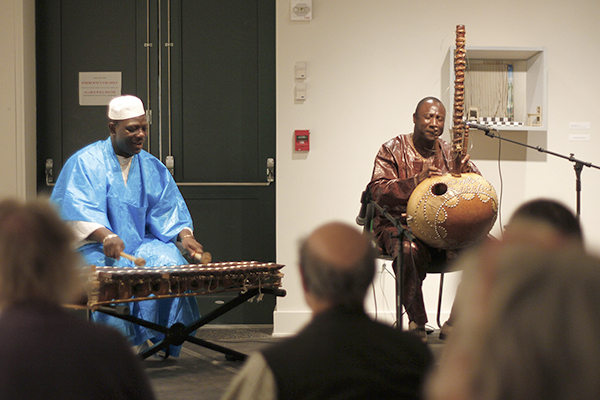
The Dorsky was transformed into a transcontinental hub on Tuesday, April 9 during its “West African Concert,” which celebrated the culture through various creative mediums.
The event included a performance by Malian musicians Yacouba Sissoko and Famoro Dioubate, along with a film series and symposium complementing “Photo-Rapide,” an ongoing exhibition by photography Professor François Deschamps.
The exhibition — which opened in January and recently closed on April 14 — was intended to “provide a nuanced glimpse of the people and culture of the West African nation of Mali,” according to the description on the Dorsky website.
“We were asked to come up with programming appropriate for West African culture, so I looked for Malian musicians of quality that would be great to bring to campus,” Deschamps said. “I went to a big Malian cultural event in Harlem in October and I just took a chance on these musicians, but it turned out to be the best.”
Sissoko, a Master Kora player, originates from the Djely Griot tradition. He has experience playing Kora, a harp-like instrument, with jazz, Latin and R&B bands as well as in traditional African ceremonies. He is the leader of his own band, Siya, and a member of the group Super Mande.
Janis Benincasa, program manager for the Dorsky, coordinated the Malian concert and described Sissoko as “a delight to work with.”
Dioubate was born in Conakry, Guinea to a Griot family. In his native country, he routinely performed for the president and visiting foreign dignitaries. He was a member of Mory Kante’s orchestra and a member of Groupe Standard. Since the late ‘90s, he has worked as a freelance musician for a variety of groups and dance companies for performances and recordings.
Considering their skepticism about the concert attendance, Benincasa and Deschamps were pleasantly surprised with the turnout.
After more than 160 audience members filled the Dorsky, creating a standing-room-only environment, the show was an “unexpected” success, according to Deschamps.
Benincasa said there was no word for the show other than “spectacular.”
“There were so many people there, half of whom I’d never seen before,” she said. “It’s great to bring in new audiences, and it was obvious that a lot of them were knowledgeable of West African music. It was truly wonderful. I hope we can have the whole ensemble back.”
Benincasa and other museum coordinators are considering asking the musicians to return, as they like to hold performances on Tuesday nights several times a year, when current museum exhibitions don’t take up much floor or wall space.
Culturally-relevant performances and creative outlets will most likely complement an upcoming Dorsky exhibition on Tibet, which will run from July to December.

